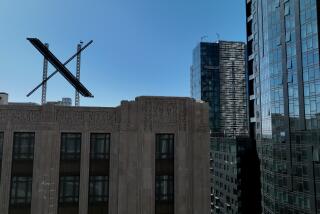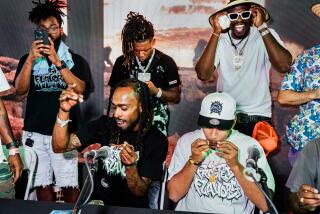‘Human Be-In’ begat the ‘60s’ Summer of Love
SAN FRANCISCO — Their hair, once a symbol of youthful rebellion, is mostly gray. Bodies that writhed with wild abandon as a guru invited them to “Tune in ... turn on ... drop out” now have stiff knees and age spots.
“How many of you are on acid right now?” rock critic Joel Selvin asked an audience of former hippies who turned out Tuesday to mark Sunday’s 40th anniversary of the Human Be-In, the counterculture event that unofficially launched San Francisco’s Summer of Love. “How many of you are on antacid right now?”
In many ways, the ‘60s as we know them began Jan. 14, 1967. And although the decade may have a new meaning for a generation contemplating retirement, those who were in Golden Gate Park that day agreed that neither they nor San Francisco have been the same since.
Part rock concert and literary event, part protest and mass consciousness-raising, the Human Be-In was billed at the time as a “Gathering of the Tribes” meant to unite and incite the different wings of the counterculture movement.
Estimates of the number of musicians, writers, visionaries, student radicals, spiritual seekers and wayward youth who cavorted on the park’s Polo Field that day range from 10,000 to 50,000.
The list of speakers and bands who appeared reads like a Who’s Who of 1960s icons: LSD advocate Timothy Leary, making his first San Francisco appearance; poets Allen Ginsberg and Gary Snyder; comedian Dick Gregory; the Grateful Dead; Jefferson Airplane. By all accounts, psychedelic drugs were in plentiful supply, courtesy of a parachuter who tossed free doses to the crowd.
“Over the years, probably a dozen people have come up to me and said, ‘You guys were fantastic!’ I say, ‘We weren’t there,’ ” laughed David Getz, drummer for Big Brother & the Holding Company, the Janis Joplin-fronted band that was not on the lineup the day of the Be-In. “And they say, ‘No, I saw you!’ Maybe they did.”
Publicity about “the happening,” as it was called, and the Monterey Pop Festival in June, encouraged thousands more young idealists to head to San Francisco by the summer. The city’s Haight-Ashbury district, just outside the park, was the flower child’s Mecca.
Jim O’Donnell, a panelist for Tuesday’s commemorative forum sponsored by the San Francisco Museum and Historical Society, recalled the transformative days leading up to the Be-In, when he went from being an engineering student at UC Berkeley to a freewheeling Haight-Ashbury resident.
“My life turned from academia to sex, drugs and rock ‘n’ roll -- unfortunately, not necessarily in that order,” he said.
Like other panelists, O’Donnell and Getz remembered the Human Be-In as both the beginning and the end, an event that would be much duplicated but never equaled.
“The Human Be-In was a creation from within the San Francisco counterculture,” Getz said. “The Summer of Love really was a creation of the national news media that befell San Francisco.”
The San Francisco Chronicle’s Selvin, who moderated the discussion, said that many of the young people who flocked to San Francisco were not emotionally equipped to handle the raw experiences they encountered there, and “some of them wound up as debris.”
But Peder Jones, an educational publisher who attended the Be-In, said that despite the drug-soaked atmosphere, “not every hippie wound up incapable and penniless.”
“We ended up doing jobs that didn’t exist when we started college. The idea of groups doing things together started to make sense,” Jones said.
Some in the crowd reminisced about how, despite having gone on to lead successful lives, they knew then they were living through extraordinary times that would resonate 40 years on.
“I was there and I enjoyed it immensely and miss it, as a matter of fact,” O’Donnell said.
More to Read
The biggest entertainment stories
Get our big stories about Hollywood, film, television, music, arts, culture and more right in your inbox as soon as they publish.
You may occasionally receive promotional content from the Los Angeles Times.










